Case Study: The Alcohol Think Again Campaign - Health Promotion
VerifiedAdded on 2022/08/20
|7
|1555
|18
Case Study
AI Summary
This case study examines the 'Alcohol Think Again' campaign, evaluating its objectives, target audience, and effectiveness in promoting responsible alcohol consumption, particularly among young people. The study delves into the campaign's overarching aims, target groups (including young people, parents, and at-risk adults), and the application of the Ottawa Charter's key action areas for health promotion. The analysis explores the use of the Health Belief Model, the selection of specific campaign components, and the utilization of mass media, including social media platforms, to disseminate the message. The study assesses the campaign's effectiveness as a health promotion tool in strengthening community action and reviews its success level, drawing comparisons with similar campaigns and referencing relevant literature. The case study highlights the importance of understanding the campaign's impact on the targeted groups and how the Ottawa charter was used to design the campaign.
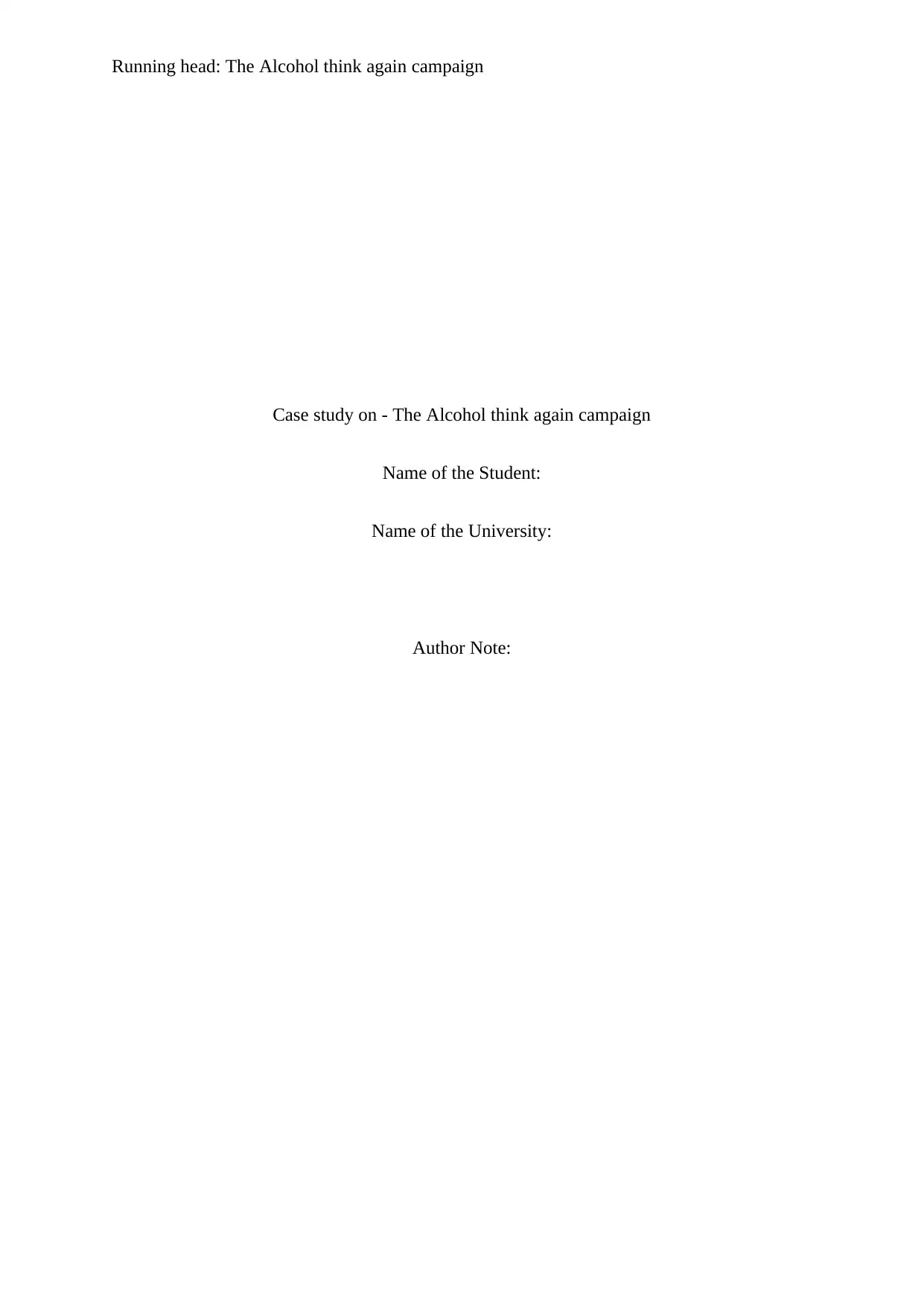
Running head: The Alcohol think again campaign
Case study on - The Alcohol think again campaign
Name of the Student:
Name of the University:
Author Note:
Case study on - The Alcohol think again campaign
Name of the Student:
Name of the University:
Author Note:
Paraphrase This Document
Need a fresh take? Get an instant paraphrase of this document with our AI Paraphraser
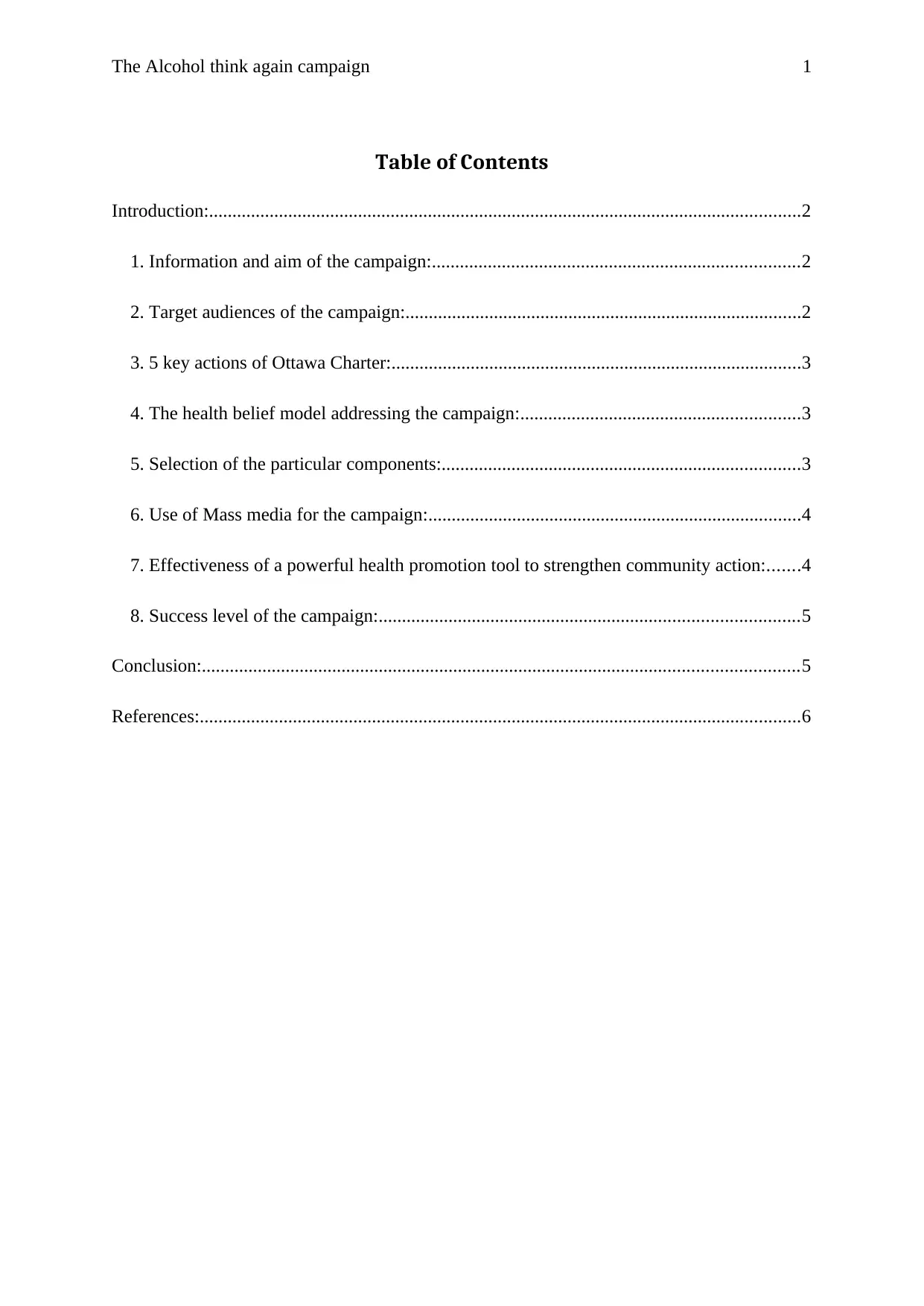
The Alcohol think again campaign 1
Table of Contents
Introduction:...............................................................................................................................2
1. Information and aim of the campaign:...............................................................................2
2. Target audiences of the campaign:.....................................................................................2
3. 5 key actions of Ottawa Charter:........................................................................................3
4. The health belief model addressing the campaign:............................................................3
5. Selection of the particular components:.............................................................................3
6. Use of Mass media for the campaign:................................................................................4
7. Effectiveness of a powerful health promotion tool to strengthen community action:.......4
8. Success level of the campaign:..........................................................................................5
Conclusion:................................................................................................................................5
References:.................................................................................................................................6
Table of Contents
Introduction:...............................................................................................................................2
1. Information and aim of the campaign:...............................................................................2
2. Target audiences of the campaign:.....................................................................................2
3. 5 key actions of Ottawa Charter:........................................................................................3
4. The health belief model addressing the campaign:............................................................3
5. Selection of the particular components:.............................................................................3
6. Use of Mass media for the campaign:................................................................................4
7. Effectiveness of a powerful health promotion tool to strengthen community action:.......4
8. Success level of the campaign:..........................................................................................5
Conclusion:................................................................................................................................5
References:.................................................................................................................................6
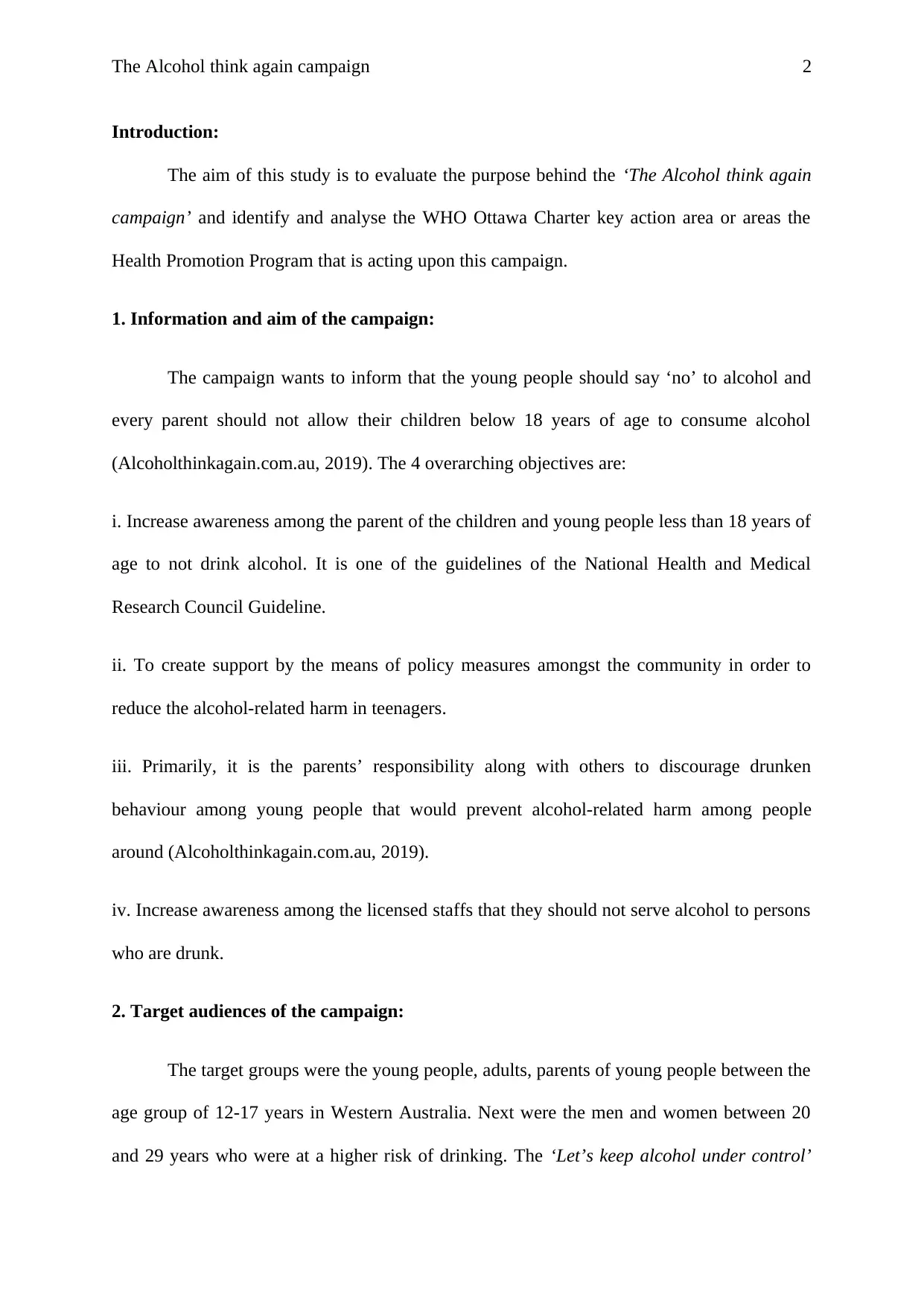
The Alcohol think again campaign 2
Introduction:
The aim of this study is to evaluate the purpose behind the ‘The Alcohol think again
campaign’ and identify and analyse the WHO Ottawa Charter key action area or areas the
Health Promotion Program that is acting upon this campaign.
1. Information and aim of the campaign:
The campaign wants to inform that the young people should say ‘no’ to alcohol and
every parent should not allow their children below 18 years of age to consume alcohol
(Alcoholthinkagain.com.au, 2019). The 4 overarching objectives are:
i. Increase awareness among the parent of the children and young people less than 18 years of
age to not drink alcohol. It is one of the guidelines of the National Health and Medical
Research Council Guideline.
ii. To create support by the means of policy measures amongst the community in order to
reduce the alcohol-related harm in teenagers.
iii. Primarily, it is the parents’ responsibility along with others to discourage drunken
behaviour among young people that would prevent alcohol-related harm among people
around (Alcoholthinkagain.com.au, 2019).
iv. Increase awareness among the licensed staffs that they should not serve alcohol to persons
who are drunk.
2. Target audiences of the campaign:
The target groups were the young people, adults, parents of young people between the
age group of 12-17 years in Western Australia. Next were the men and women between 20
and 29 years who were at a higher risk of drinking. The ‘Let’s keep alcohol under control’
Introduction:
The aim of this study is to evaluate the purpose behind the ‘The Alcohol think again
campaign’ and identify and analyse the WHO Ottawa Charter key action area or areas the
Health Promotion Program that is acting upon this campaign.
1. Information and aim of the campaign:
The campaign wants to inform that the young people should say ‘no’ to alcohol and
every parent should not allow their children below 18 years of age to consume alcohol
(Alcoholthinkagain.com.au, 2019). The 4 overarching objectives are:
i. Increase awareness among the parent of the children and young people less than 18 years of
age to not drink alcohol. It is one of the guidelines of the National Health and Medical
Research Council Guideline.
ii. To create support by the means of policy measures amongst the community in order to
reduce the alcohol-related harm in teenagers.
iii. Primarily, it is the parents’ responsibility along with others to discourage drunken
behaviour among young people that would prevent alcohol-related harm among people
around (Alcoholthinkagain.com.au, 2019).
iv. Increase awareness among the licensed staffs that they should not serve alcohol to persons
who are drunk.
2. Target audiences of the campaign:
The target groups were the young people, adults, parents of young people between the
age group of 12-17 years in Western Australia. Next were the men and women between 20
and 29 years who were at a higher risk of drinking. The ‘Let’s keep alcohol under control’
⊘ This is a preview!⊘
Do you want full access?
Subscribe today to unlock all pages.

Trusted by 1+ million students worldwide
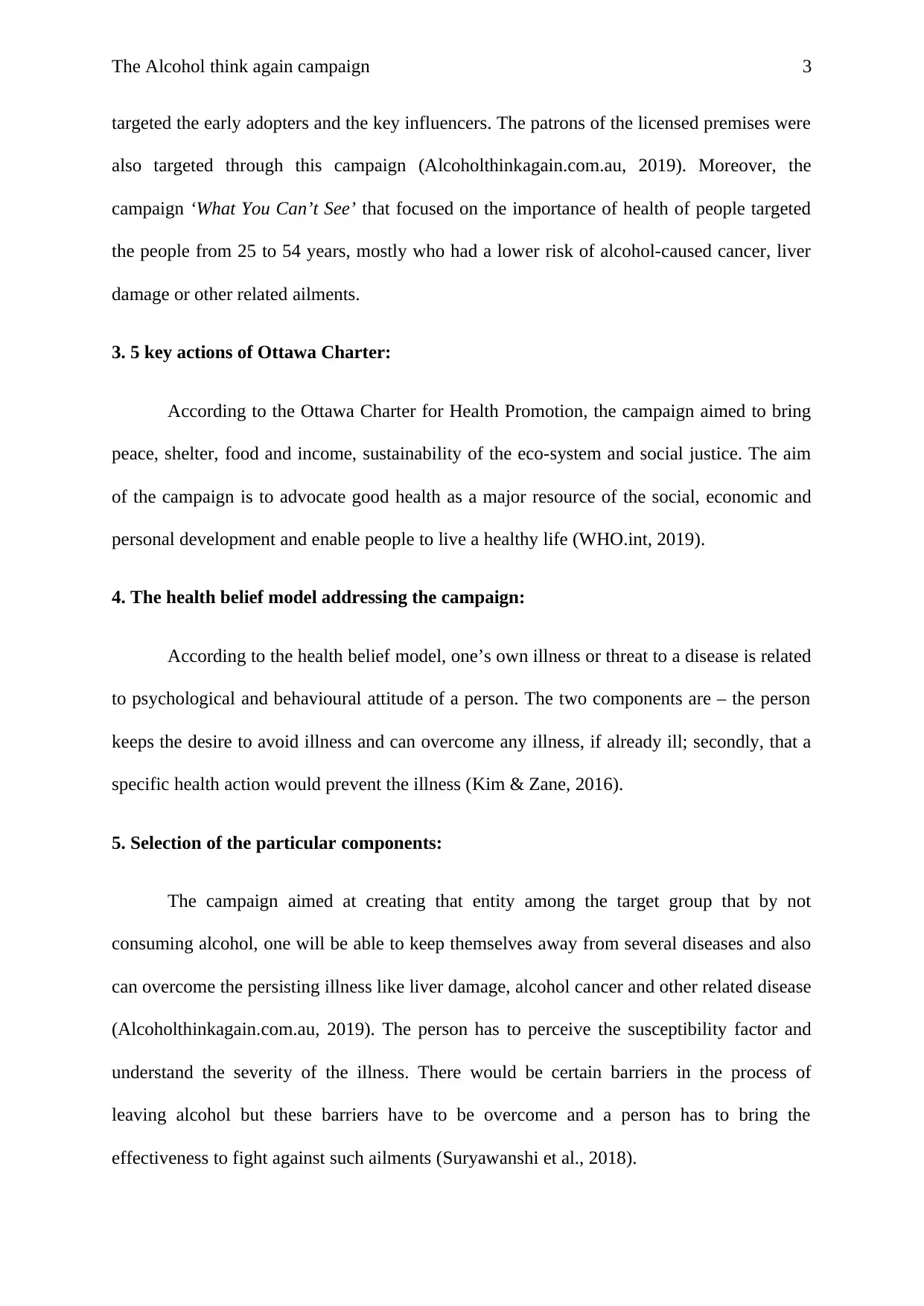
The Alcohol think again campaign 3
targeted the early adopters and the key influencers. The patrons of the licensed premises were
also targeted through this campaign (Alcoholthinkagain.com.au, 2019). Moreover, the
campaign ‘What You Can’t See’ that focused on the importance of health of people targeted
the people from 25 to 54 years, mostly who had a lower risk of alcohol-caused cancer, liver
damage or other related ailments.
3. 5 key actions of Ottawa Charter:
According to the Ottawa Charter for Health Promotion, the campaign aimed to bring
peace, shelter, food and income, sustainability of the eco-system and social justice. The aim
of the campaign is to advocate good health as a major resource of the social, economic and
personal development and enable people to live a healthy life (WHO.int, 2019).
4. The health belief model addressing the campaign:
According to the health belief model, one’s own illness or threat to a disease is related
to psychological and behavioural attitude of a person. The two components are – the person
keeps the desire to avoid illness and can overcome any illness, if already ill; secondly, that a
specific health action would prevent the illness (Kim & Zane, 2016).
5. Selection of the particular components:
The campaign aimed at creating that entity among the target group that by not
consuming alcohol, one will be able to keep themselves away from several diseases and also
can overcome the persisting illness like liver damage, alcohol cancer and other related disease
(Alcoholthinkagain.com.au, 2019). The person has to perceive the susceptibility factor and
understand the severity of the illness. There would be certain barriers in the process of
leaving alcohol but these barriers have to be overcome and a person has to bring the
effectiveness to fight against such ailments (Suryawanshi et al., 2018).
targeted the early adopters and the key influencers. The patrons of the licensed premises were
also targeted through this campaign (Alcoholthinkagain.com.au, 2019). Moreover, the
campaign ‘What You Can’t See’ that focused on the importance of health of people targeted
the people from 25 to 54 years, mostly who had a lower risk of alcohol-caused cancer, liver
damage or other related ailments.
3. 5 key actions of Ottawa Charter:
According to the Ottawa Charter for Health Promotion, the campaign aimed to bring
peace, shelter, food and income, sustainability of the eco-system and social justice. The aim
of the campaign is to advocate good health as a major resource of the social, economic and
personal development and enable people to live a healthy life (WHO.int, 2019).
4. The health belief model addressing the campaign:
According to the health belief model, one’s own illness or threat to a disease is related
to psychological and behavioural attitude of a person. The two components are – the person
keeps the desire to avoid illness and can overcome any illness, if already ill; secondly, that a
specific health action would prevent the illness (Kim & Zane, 2016).
5. Selection of the particular components:
The campaign aimed at creating that entity among the target group that by not
consuming alcohol, one will be able to keep themselves away from several diseases and also
can overcome the persisting illness like liver damage, alcohol cancer and other related disease
(Alcoholthinkagain.com.au, 2019). The person has to perceive the susceptibility factor and
understand the severity of the illness. There would be certain barriers in the process of
leaving alcohol but these barriers have to be overcome and a person has to bring the
effectiveness to fight against such ailments (Suryawanshi et al., 2018).
Paraphrase This Document
Need a fresh take? Get an instant paraphrase of this document with our AI Paraphraser
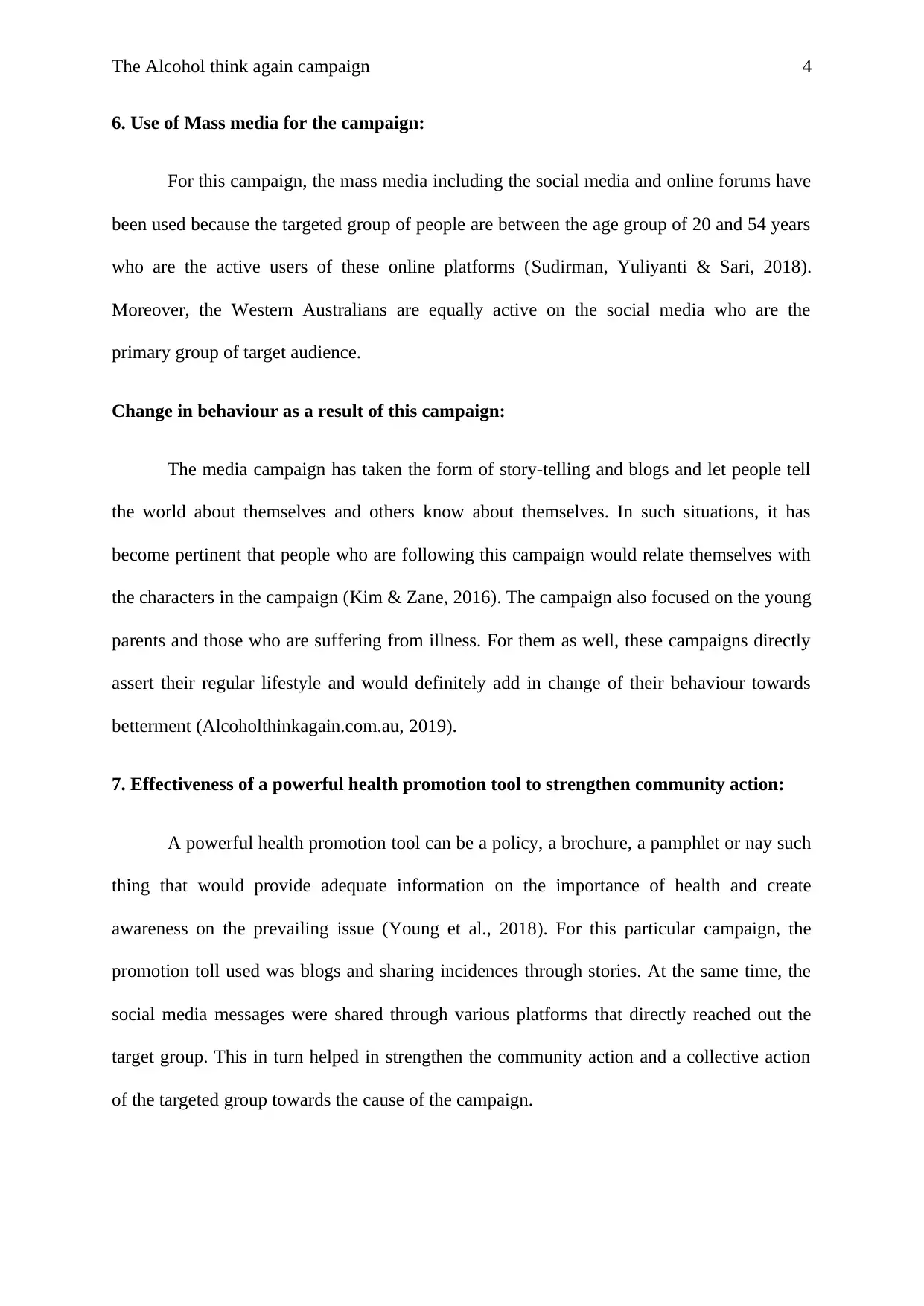
The Alcohol think again campaign 4
6. Use of Mass media for the campaign:
For this campaign, the mass media including the social media and online forums have
been used because the targeted group of people are between the age group of 20 and 54 years
who are the active users of these online platforms (Sudirman, Yuliyanti & Sari, 2018).
Moreover, the Western Australians are equally active on the social media who are the
primary group of target audience.
Change in behaviour as a result of this campaign:
The media campaign has taken the form of story-telling and blogs and let people tell
the world about themselves and others know about themselves. In such situations, it has
become pertinent that people who are following this campaign would relate themselves with
the characters in the campaign (Kim & Zane, 2016). The campaign also focused on the young
parents and those who are suffering from illness. For them as well, these campaigns directly
assert their regular lifestyle and would definitely add in change of their behaviour towards
betterment (Alcoholthinkagain.com.au, 2019).
7. Effectiveness of a powerful health promotion tool to strengthen community action:
A powerful health promotion tool can be a policy, a brochure, a pamphlet or nay such
thing that would provide adequate information on the importance of health and create
awareness on the prevailing issue (Young et al., 2018). For this particular campaign, the
promotion toll used was blogs and sharing incidences through stories. At the same time, the
social media messages were shared through various platforms that directly reached out the
target group. This in turn helped in strengthen the community action and a collective action
of the targeted group towards the cause of the campaign.
6. Use of Mass media for the campaign:
For this campaign, the mass media including the social media and online forums have
been used because the targeted group of people are between the age group of 20 and 54 years
who are the active users of these online platforms (Sudirman, Yuliyanti & Sari, 2018).
Moreover, the Western Australians are equally active on the social media who are the
primary group of target audience.
Change in behaviour as a result of this campaign:
The media campaign has taken the form of story-telling and blogs and let people tell
the world about themselves and others know about themselves. In such situations, it has
become pertinent that people who are following this campaign would relate themselves with
the characters in the campaign (Kim & Zane, 2016). The campaign also focused on the young
parents and those who are suffering from illness. For them as well, these campaigns directly
assert their regular lifestyle and would definitely add in change of their behaviour towards
betterment (Alcoholthinkagain.com.au, 2019).
7. Effectiveness of a powerful health promotion tool to strengthen community action:
A powerful health promotion tool can be a policy, a brochure, a pamphlet or nay such
thing that would provide adequate information on the importance of health and create
awareness on the prevailing issue (Young et al., 2018). For this particular campaign, the
promotion toll used was blogs and sharing incidences through stories. At the same time, the
social media messages were shared through various platforms that directly reached out the
target group. This in turn helped in strengthen the community action and a collective action
of the targeted group towards the cause of the campaign.
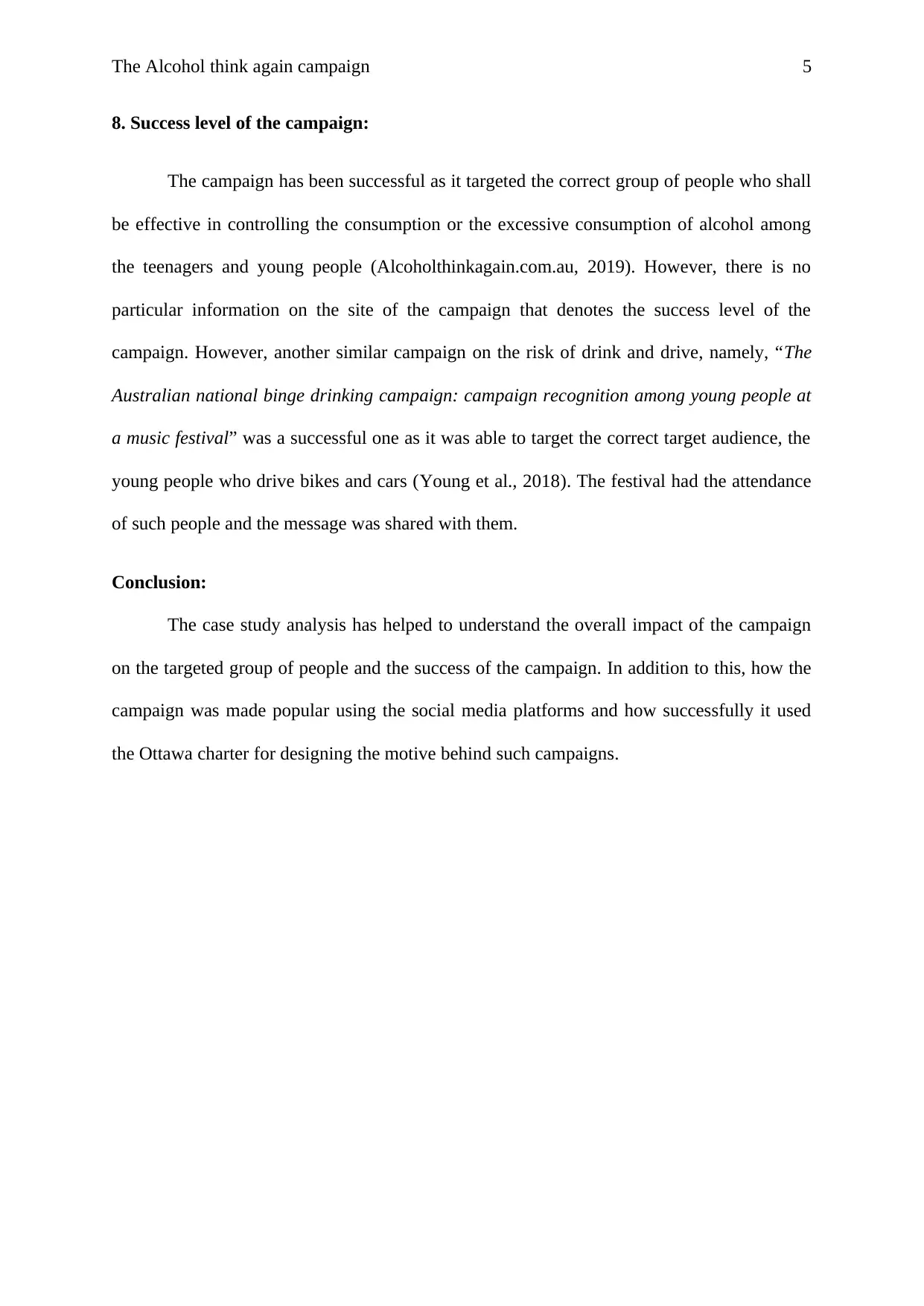
The Alcohol think again campaign 5
8. Success level of the campaign:
The campaign has been successful as it targeted the correct group of people who shall
be effective in controlling the consumption or the excessive consumption of alcohol among
the teenagers and young people (Alcoholthinkagain.com.au, 2019). However, there is no
particular information on the site of the campaign that denotes the success level of the
campaign. However, another similar campaign on the risk of drink and drive, namely, “The
Australian national binge drinking campaign: campaign recognition among young people at
a music festival” was a successful one as it was able to target the correct target audience, the
young people who drive bikes and cars (Young et al., 2018). The festival had the attendance
of such people and the message was shared with them.
Conclusion:
The case study analysis has helped to understand the overall impact of the campaign
on the targeted group of people and the success of the campaign. In addition to this, how the
campaign was made popular using the social media platforms and how successfully it used
the Ottawa charter for designing the motive behind such campaigns.
8. Success level of the campaign:
The campaign has been successful as it targeted the correct group of people who shall
be effective in controlling the consumption or the excessive consumption of alcohol among
the teenagers and young people (Alcoholthinkagain.com.au, 2019). However, there is no
particular information on the site of the campaign that denotes the success level of the
campaign. However, another similar campaign on the risk of drink and drive, namely, “The
Australian national binge drinking campaign: campaign recognition among young people at
a music festival” was a successful one as it was able to target the correct target audience, the
young people who drive bikes and cars (Young et al., 2018). The festival had the attendance
of such people and the message was shared with them.
Conclusion:
The case study analysis has helped to understand the overall impact of the campaign
on the targeted group of people and the success of the campaign. In addition to this, how the
campaign was made popular using the social media platforms and how successfully it used
the Ottawa charter for designing the motive behind such campaigns.
⊘ This is a preview!⊘
Do you want full access?
Subscribe today to unlock all pages.

Trusted by 1+ million students worldwide
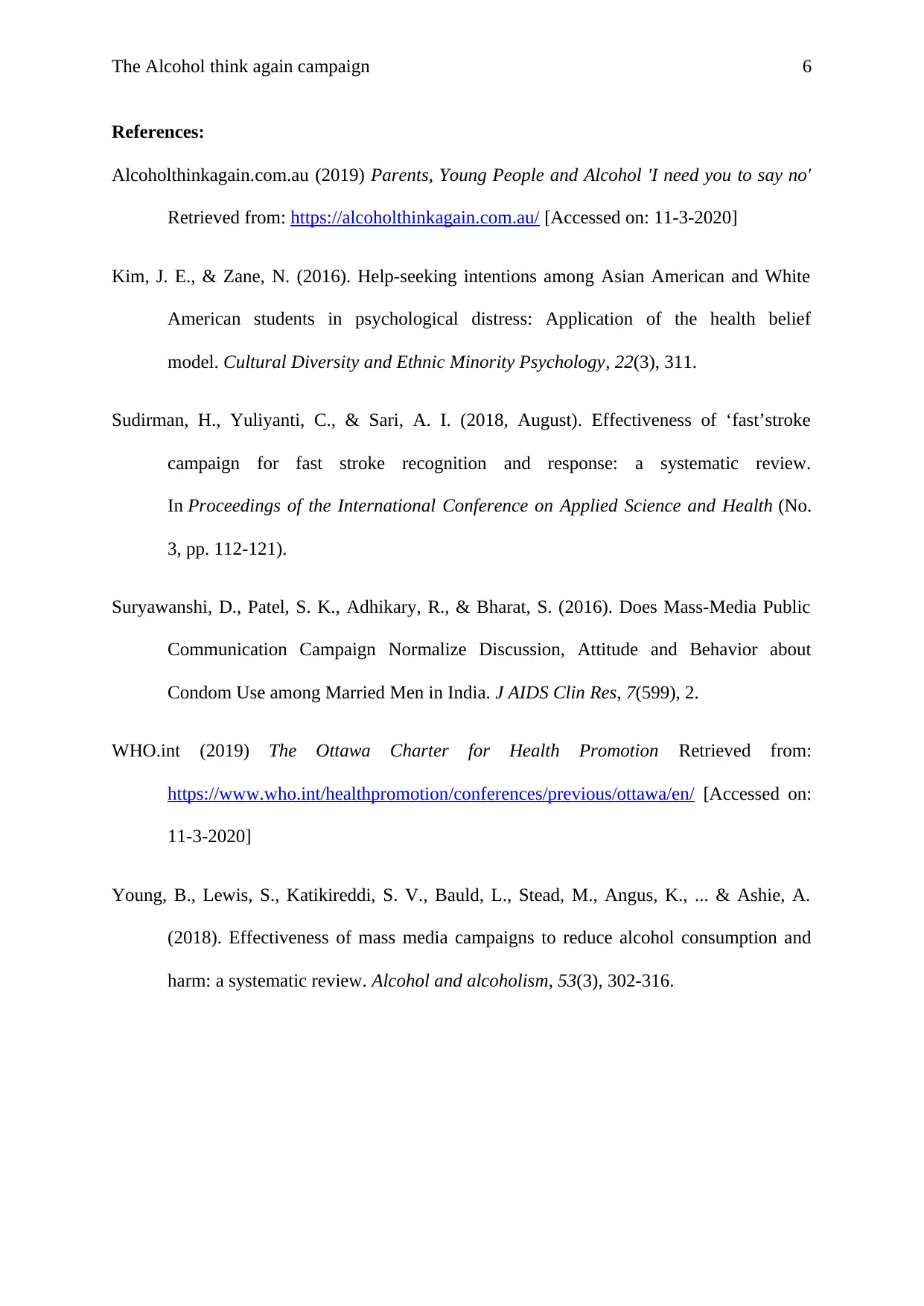
The Alcohol think again campaign 6
References:
Alcoholthinkagain.com.au (2019) Parents, Young People and Alcohol 'I need you to say no'
Retrieved from: https://alcoholthinkagain.com.au/ [Accessed on: 11-3-2020]
Kim, J. E., & Zane, N. (2016). Help-seeking intentions among Asian American and White
American students in psychological distress: Application of the health belief
model. Cultural Diversity and Ethnic Minority Psychology, 22(3), 311.
Sudirman, H., Yuliyanti, C., & Sari, A. I. (2018, August). Effectiveness of ‘fast’stroke
campaign for fast stroke recognition and response: a systematic review.
In Proceedings of the International Conference on Applied Science and Health (No.
3, pp. 112-121).
Suryawanshi, D., Patel, S. K., Adhikary, R., & Bharat, S. (2016). Does Mass-Media Public
Communication Campaign Normalize Discussion, Attitude and Behavior about
Condom Use among Married Men in India. J AIDS Clin Res, 7(599), 2.
WHO.int (2019) The Ottawa Charter for Health Promotion Retrieved from:
https://www.who.int/healthpromotion/conferences/previous/ottawa/en/ [Accessed on:
11-3-2020]
Young, B., Lewis, S., Katikireddi, S. V., Bauld, L., Stead, M., Angus, K., ... & Ashie, A.
(2018). Effectiveness of mass media campaigns to reduce alcohol consumption and
harm: a systematic review. Alcohol and alcoholism, 53(3), 302-316.
References:
Alcoholthinkagain.com.au (2019) Parents, Young People and Alcohol 'I need you to say no'
Retrieved from: https://alcoholthinkagain.com.au/ [Accessed on: 11-3-2020]
Kim, J. E., & Zane, N. (2016). Help-seeking intentions among Asian American and White
American students in psychological distress: Application of the health belief
model. Cultural Diversity and Ethnic Minority Psychology, 22(3), 311.
Sudirman, H., Yuliyanti, C., & Sari, A. I. (2018, August). Effectiveness of ‘fast’stroke
campaign for fast stroke recognition and response: a systematic review.
In Proceedings of the International Conference on Applied Science and Health (No.
3, pp. 112-121).
Suryawanshi, D., Patel, S. K., Adhikary, R., & Bharat, S. (2016). Does Mass-Media Public
Communication Campaign Normalize Discussion, Attitude and Behavior about
Condom Use among Married Men in India. J AIDS Clin Res, 7(599), 2.
WHO.int (2019) The Ottawa Charter for Health Promotion Retrieved from:
https://www.who.int/healthpromotion/conferences/previous/ottawa/en/ [Accessed on:
11-3-2020]
Young, B., Lewis, S., Katikireddi, S. V., Bauld, L., Stead, M., Angus, K., ... & Ashie, A.
(2018). Effectiveness of mass media campaigns to reduce alcohol consumption and
harm: a systematic review. Alcohol and alcoholism, 53(3), 302-316.
1 out of 7
Related Documents
Your All-in-One AI-Powered Toolkit for Academic Success.
+13062052269
info@desklib.com
Available 24*7 on WhatsApp / Email
![[object Object]](/_next/static/media/star-bottom.7253800d.svg)
Unlock your academic potential
Copyright © 2020–2025 A2Z Services. All Rights Reserved. Developed and managed by ZUCOL.





